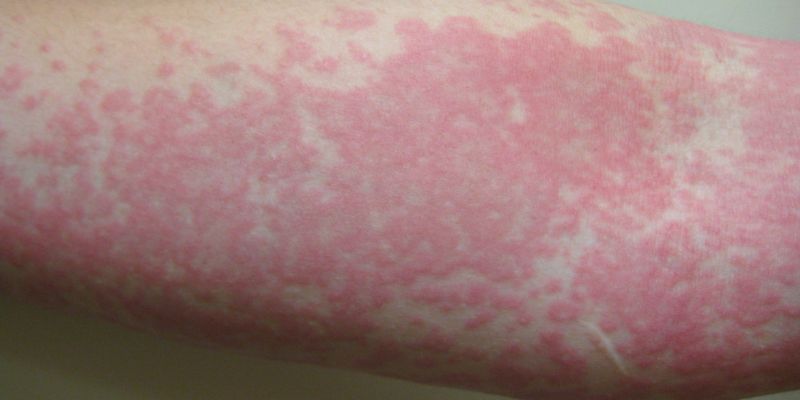Hives, or urticaria as it is called in the medical community, are very prevalent but may be difficult to explain and treat. Imagine the shock and discomfort of waking up to see red, itching welts all over your body. Since hives may arise out of nowhere, creating pain and worry, it's important to learn more about what causes them and the many ways they can be treated. In order to preserve skin health and general well-being, it is important to get an understanding of this common ailment as a first step in preventing and successfully managing it. This in-depth guide will provide you with the knowledge you need to avoid and manage hives on the skin, whether you are currently experiencing them or just curious about them.
Understanding Hives on Skin
Hives, also known as urticaria, are red, itchy bumps of varied sizes and shapes that appear on the skin. A frequent skin ailment that reflects an aberrant immunological response, they may cause considerable pain without being life-threatening in most cases.
Common Causes of Hives
The history of hives is complex and has several different beginnings. Allergic reactions to things like pollen, cat dander, or even certain foods are a common cause of hives. Stress, an ever-present part of our hectic modern lives, is another common cause of skin problems like hives. Hives are often triggered by exposure to certain chemicals, extreme temperatures, or insect attacks. The amazing intricacy of hive causes highlights the need of living a healthy lifestyle and being aware of our immediate environment and the food we put in our bodies. To avoid hives and keep this skin disease under control, it is crucial to be aware of the many factors that set off our immune systems' defensive response.

Preventing Hives on Skin
Hives are welts that form on the skin and are elevated, red, and itchy. They are often caused by an allergic response. Hives may be avoided by a mix of behavioral, nutritional, and medicinal measures, all of which contribute to the maintenance of clean, healthy skin. These preventative steps are crucial in minimizing the risk of an outbreak of hives and addressing the underlying causes. Taking into account individual circumstances, such as known allergies and specific health concerns, and adopting tactics that are customized to suit these requirements is essential for a holistic approach to prevention.
Lifestyle Changes
Changing one's habits is important for avoiding hives. Hives may be prevented if the allergens that cause them are isolated and removed from the environment. Pollen, pet dander, and insect bites are just a few of the most common allergens. Hives may be triggered by stress, so it's crucial to practice stress management strategies like getting enough sleep, stretching, and breathing exercises on a regular basis. Hives may be avoided by taking preventative measures, such as drinking enough water and practicing good hygiene. The danger may be drastically reduced and health much improved by adopting a better way of living.
Dietary Adjustments
Food allergies are a significant cause of hives, making it imperative that you adopt a healthy diet. Fruits, vegetables, lean meats, and whole grains all include vital nutrients that aid in immune system function and skin quality when consumed on a regular basis. Those who suffer from food allergies must take special care to identify and avoid potential trigger foods. If you have trouble pinpointing the source of your symptoms, keeping a food diary may assist. Keeping yourself hydrated is also crucial since it helps your skin retain its suppleness and keeps your body running smoothly. The risk of developing hives may be greatly reduced by following a diet designed specifically for each person.

Medical Precautions
Hives may be prevented and their causes identified with regular medical exams and consultations. Allergy testing may be performed by a doctor to determine which substances cause an allergic reaction, and then patients can take preventative measures to avoid them. Hives may be managed and prevented with the use of antihistamines and other drugs, which can be obtained with a doctor's prescription. Healthcare providers may refer patients with persistent hives to immunologists or allergists for further examination and individualized therapy. Medical precautions allow people to learn about their disease, get the help they need, and reduce their risk of hives.
Treatment Options for Hives
Various therapeutic alternatives, including OTC remedies, prescription drugs, and alternative therapies, are readily accessible. Timely treatment is crucial for controlling hives' symptoms and avoiding consequences. By trying out several remedies, people may identify the ones that work best for them to reduce pain and speed up the skin's healing process.
Over-the-Counter Solutions
First-line treatments for hives often consist of OTC medications. Most people's first choice for over-the-counter (OTC) relief from inflammation and itching is antihistamines, which work by inhibiting the histamine that triggers these reactions. Available over-the-counter medications such as Benadryl, Zyrtec, and Claritin may help alleviate mild to severe hives. Hydrocortisone topical creams may also be administered on the hives to alleviate the itching and swelling. Hives may often be treated with over-the-counter medications, but if the symptoms continue or increase after taking the prescribed amount, you should see a doctor.
Prescription Medications
Stronger drugs may be prescribed by doctors for instances of hives that are very severe or don't respond to over-the-counter treatments. When over-the-counter antihistamines aren't cutting it, your doctor may suggest a prescription. Prednisone and other corticosteroids might be taken for brief periods of time to alleviate inflammation and pain. Injections of omalizumab (Xolair) may be used to modulate the immune response and prevent outbreaks in patients with persistent hives. Adherence to recommended doses and treatment programs is essential, since these drugs are given only after careful examination of the individual's condition.
Alternative Treatments
Alternative medicine and home remedies are used by some people who suffer with hives. Itching and inflammation may be relieved by applying cold compresses to the afflicted regions. The gel from aloe vera plants is another natural treatment with calming and anti-inflammatory effects. Holistic treatments like acupuncture and hypnotherapy may be helpful for some individuals with hives because they work to restore energy balance and alter an individual's reaction to stress. It is important to talk to a doctor about any alternative therapies you're considering to be sure they're safe and suitable for your unique health situation and requirements.
Managing Hives in Everyday Life
Seeking prompt medical help to identify triggers and suitable therapies is an important part of taking a proactive approach to managing hives. Avoiding triggers by changing one's food and routine may significantly cut down on allergic reactions. It's possible to have a better quality of life while having hives by maintaining low levels of stress, eating healthily, and learning as much as possible about the illness.
Conclusion
It is crucial to your skin's health and general well-being that you learn about and take steps to avoid hives or urticaria. The best way to deal with hives is to take a comprehensive and well-informed strategy, which may include anything from changing your food and lifestyle to seeking medical attention. To live a life that is less impacted by this common skin ailment, one must be proactive, be educated, and make conscious decisions in order to maintain a healthy, hive-free equilibrium.




